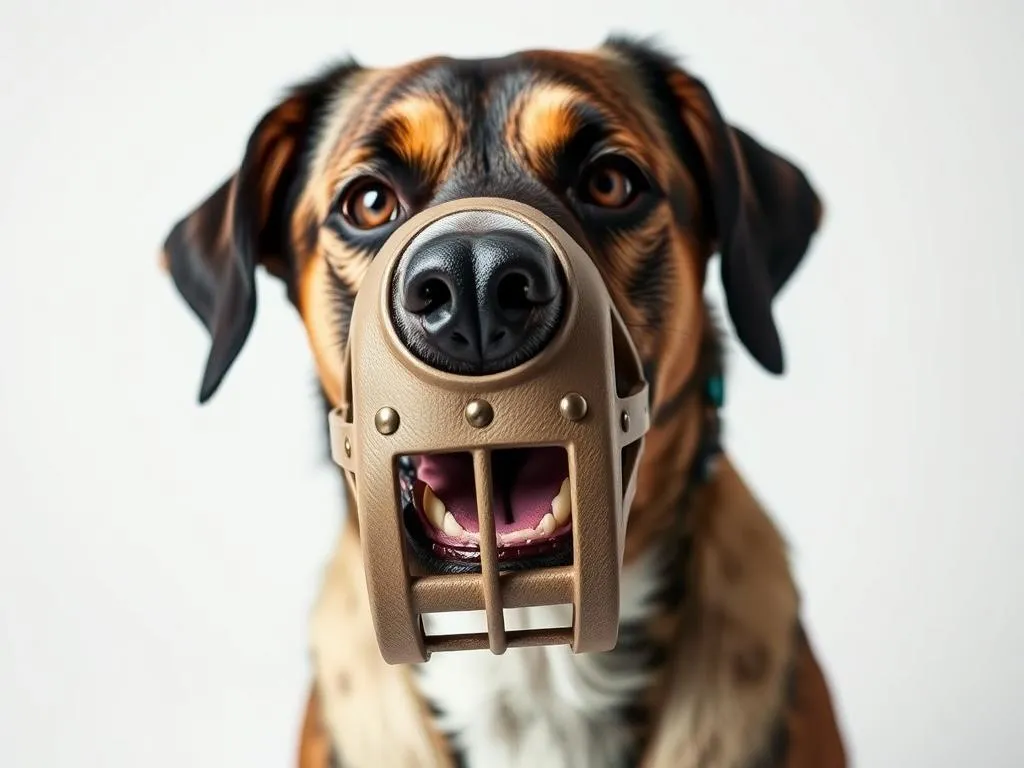
Muzzles are essential tools in the realm of dog training and safety. They serve various purposes, from preventing biting to ensuring the safety of your dog and others during stressful situations. Understanding when and why a dog might need a muzzle can significantly improve interactions and experiences for both the dog and the owner. As costs for pet supplies can add up, creating a DIY dog muzzle provides a customizable and cost-effective solution tailored to your dog’s specific needs.
Let’s delve into the world of dog muzzles, their usage, and how to make one yourself.
Understanding Dog Muzzles
What is a Dog Muzzle?
A dog muzzle is a device designed to cover the snout of a dog, preventing it from biting or barking. Muzzles come in various styles, with the most common types being basket muzzles and soft muzzles.
- Basket Muzzles: Made of rigid materials, these muzzles allow the dog to open its mouth slightly, facilitating breathing and panting while preventing biting.
- Cloth Muzzles: Typically made from soft fabric, these are more comfortable but may restrict the dog’s ability to pant or drink.
Understanding the purpose of each type can help you choose the right one for your dog’s needs.
Situations Requiring a Muzzle
There are several scenarios where a muzzle might be necessary:
- Vet Visits: Dogs can become anxious or defensive during medical examinations. A muzzle ensures safety for both the veterinarian and the dog.
- Grooming Sessions: Whether it’s nail trimming or bathing, some dogs may feel threatened and react aggressively. A muzzle can help ease this tension.
- Interaction with Other Dogs or People: If your dog has a history of aggression or fear towards other dogs or strangers, a muzzle can provide a safety net during introductions.
- Behavioral Issues: Dogs that display anxiety or aggression may need a muzzle as part of their management strategy.
Benefits of Using a Muzzle
Using a muzzle can offer numerous benefits:
- Safety: Protect your dog and others from potential harm.
- Confidence: Knowing your dog is safely muzzled can alleviate stress for owners in challenging situations.
- Training Facilitation: A muzzle can help in the training process, allowing for gradual exposure to triggers in a controlled manner.
Considerations Before Making a DIY Dog Muzzle
Assessing Your Dog’s Needs
Before embarking on creating a DIY dog muzzle, it’s crucial to assess your dog’s specific needs:
- Breed-Specific Considerations: Different breeds have varying snout shapes and sizes, which affects muzzle fit.
- Size and Shape of the Dog’s Snout: Measure your dog’s snout accurately to ensure a comfortable fit.
- Behavioral Tendencies: Consider your dog’s temperament and history with anxiety or aggression.
Safety and Comfort
Safety and comfort should be top priorities:
- Materials to Avoid: Steer clear of materials that can cause chafing or discomfort, such as rough fabrics or stiff plastics.
- Importance of Proper Fit: A muzzle that is too tight can cause distress, while one that is too loose may not be effective.
- Monitoring Your Dog: Always supervise your dog while it’s wearing a muzzle, especially during the initial introduction.
Legal and Ethical Considerations
In some regions, there are legal requirements regarding muzzle usage. It’s essential to understand these regulations. Additionally, always pair muzzle use with positive reinforcement training. Muzzles should not be seen as a long-term solution; instead, they are often a part of a broader training and behavior modification plan.
Materials Needed for a DIY Dog Muzzle
Common Materials
To create a DIY dog muzzle, you’ll need to gather some common materials:
- Fabric Options: Consider soft yet durable fabrics like nylon or cotton.
- Velcro, Straps, and Buckles: These will help secure the muzzle comfortably.
- Alternative Materials: For a basket muzzle, wire mesh can be a viable option, but it requires careful handling during assembly.
Tools Required
You’ll also need a few basic tools:
- Sewing Machine or Needle and Thread: Depending on your sewing skills, you can choose either method.
- Scissors: For cutting fabric and straps.
- Measuring Tape: Accurate measurements are crucial for fit.
Step-by-Step Guide to Making a DIY Dog Muzzle
Measuring Your Dog
Accurate measurements are essential for a well-fitting muzzle. Here’s how to measure your dog:
- Snout Length: Measure from the tip of the nose to the base of the snout.
- Snout Circumference: Measure around the widest part of the snout.
- Head Circumference: Measure around the dog’s head, just behind the ears.
Ensure you have your dog standing comfortably to get accurate measurements.
Creating the Muzzle Design
Based on your measurements, you can create a muzzle design. Here are two common designs:
- Soft Muzzle Design: Cut two pieces of fabric that can wrap around the snout, leaving extra length for fastening.
- Basket Muzzle Design: Create a base frame using wire mesh and ensure it’s shaped to allow slight movement.
Assembling the Muzzle
Once you have your design, it’s time to assemble:
- If making a soft muzzle, sew the two fabric pieces together, leaving openings for the straps.
- For a basket muzzle, carefully attach the wire mesh pieces together, ensuring there are no sharp edges.
- Use Velcro or buckles for easy fastening.
Testing the Muzzle
Before fully introducing the muzzle, it’s essential to test it:
- Introduce Gradually: Allow your dog to sniff and explore the muzzle before putting it on.
- Short Trials: Start with short periods, gradually increasing the time your dog wears it.
- Observe for Discomfort: Watch for signs of distress, like excessive drooling or attempts to pull the muzzle off.
Adjust the fit as needed for comfort and security.
Training Your Dog to Wear a Muzzle
Positive Reinforcement Techniques
Training your dog to accept a muzzle can be a smooth process with positive reinforcement:
- Using Treats and Praise: Reward your dog with treats and praise when it shows interest in the muzzle.
- Gradual Desensitization: Slowly increase the time the muzzle is worn, pairing it with enjoyable activities.
Common Challenges and Solutions
Some dogs may resist wearing a muzzle. Here are common challenges and ways to address them:
- Resistance to Wearing the Muzzle: If your dog is resistant, take steps back and reintroduce the muzzle slowly.
- Fear or Anxiety Responses: If your dog shows signs of anxiety, try to create a calm environment and associate the muzzle with positive experiences.
When to Seek Professional Help
If you find your dog is consistently struggling with muzzle training, it may be time to consult a professional trainer. They can provide strategies tailored to your dog’s individual needs, ensuring a more successful outcome.
Alternatives to DIY Dog Muzzles
Store-Bought Options
While creating a DIY dog muzzle is a great option, store-bought muzzles can also be effective. Here are some considerations:
- Overview of Various Types: Explore different styles such as basket muzzles, soft muzzles, and wire muzzles.
- Pros and Cons: Store-bought muzzles save time and effort but may not always fit perfectly, making a DIY option more appealing for some.
Other Safety Equipment
Besides muzzles, other safety equipment can enhance your dog’s safety:
- Harnesses and Collars: These can provide comfort and security during walks, reducing the need for a muzzle in some situations.
- Training Aids: Consider other training tools that complement muzzle use, such as clickers or training collars.
Conclusion
Muzzles play a vital role in dog care, ensuring safety for both dogs and humans in various situations. Opting for a DIY dog muzzle allows for customization and cost savings while ensuring your dog’s comfort and safety. As you embark on this journey, remember to prioritize your dog’s needs, train with patience, and always keep their well-being at the forefront.
Sharing experiences or questions in the comments can foster a community of understanding and support among dog owners navigating the world of muzzles. Your dog’s comfort and safety are worth the effort!









